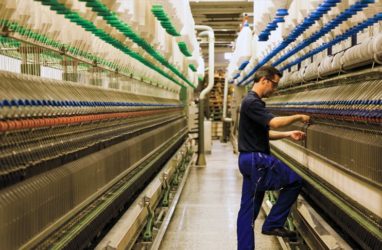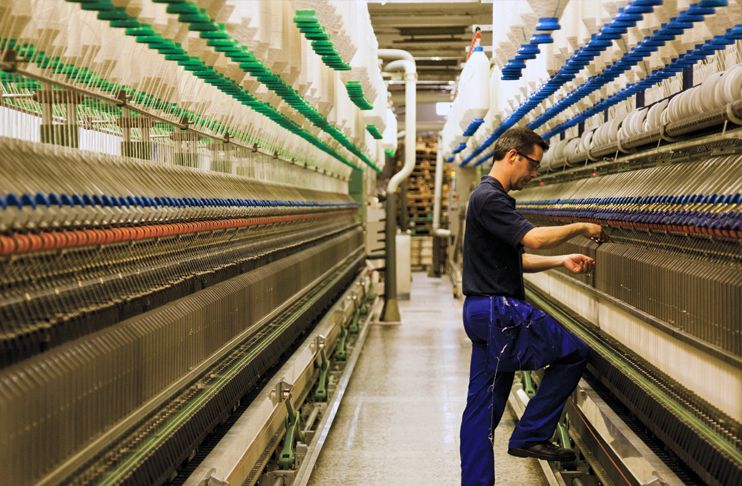
Growth in textile machinery business in the global market continued in 2017. According to the ITMF report, significant shipment increases were achieved in almost all machine groups.
Textile machinery industry closed the year 2017 with increasing numbers. Compared to the year 2016, in 2017, there was an increase of 21% in short-staple spindles, 46% in long-staple spindles and 24% in open-end rotor machines. Shipped draw-texturing spindles increased by 23% and shuttle-less looms increased by 13%. Shipments of new electronic flat knitting machines and finishing machines of the category “fabric discontinuous” each rose by 44% year-on-year. In contrast, deliveries of circular knitting machines stagnated in
The International Textile Manufacturers’ Federation (ITMF) annually publishes the International Textile Machinery Shipment Statistics (ITMSS), which shows that there is a net increase in all of the year 2017. The report covers six sections of textile machinery; spinning, draw-texturing, weaving, large circular knitting, flat knitting and finishing. This 40th ITMSS covering the data of the year 2017 was compiled in cooperation with more than 200 textile machinery manufacturers to represent world production in a comprehensive manner.
Shipment on spinning machines increase
Shipments of new short-staple spindles increased for the first time since 2013. The level of short-staple spindles improved by about 1.65 million spindles. Most of the new short-staple spindles (95%) were shipped to Asia, whereby shipments rose by almost 24% year-on-year. Thereby China, the world’s largest investor of short-staple spindles, experienced an increase of 34%, whereas deliveries to Bangladesh and Vietnam decreased by 33% and 39%, respectively. Shipments to Indonesia strongly increase last year (+ 135%). The six largest investors in the short-staple segment in 2017 where China, India, Uzbekistan, Bangladesh, Pakistan, and Indonesia.
Global shipments of long-staple (wool) spindles rose by 46% from around 114’000 in 2016 to nearly 165’000 in 2017. Deliveries to Iran soared by 445% from just around 11’000 in 2016 to around 59’000 spindles in 2017. The majority of long-staple spindles (68%) were shipped to China. 30% of long-staple spindles were shipped to Europe.
Shipments of open-end rotors rose by 24% to a level over 788’000 rotors in 2017. About 85% of worldwide shipments of open-end rotors were destined for Asia. Thereby, deliveries to Asia increased by about 15% to nearly 674’000 rotors. However, China, the world’s largest investor in open-end rotors, increased its investments by only 6% in 2017 when countries like Iran, Brazil, Uzbekistan, and Japan saw 2 to 4 times more deliveries compared to 2016. The world’s second and third largest investors in 2016 were Turkey and India.
Texturing Machinery
Global shipments of single heater draw-texturing spindles (mainly used for polyamide filaments) decreased by 87% from nearly 8’500 in 2016 to 1’060 in 2017. With a share of 50%, Asia is the region where most of the single heater draw-texturing spindles were shipped to, followed by Eastern and Western Europe with a share of 36% and 8%, respectively.
In the segment of double heater draw-texturing spindles (mainly used for polyester filaments) the downward trend ended and global shipments increased by 27% on an annual basis to about 340’000 spindles. Asia’s share of worldwide shipments amounted to 90%. Thereby, China remained the largest investor accounting for 66% of global shipments.
Weaving Machinery
In 2017, worldwide shipments of shuttle-less looms increased by 12% to 95’400 units. Thereby, shipments of air-jet, water-jet, and rapier/projectile shuttle-less looms increased by 18% (to almost 27’000), 14% (to 36’200), and 7% (to 32’000), respectively.
Not surprisingly, the main destination of shipments of all shuttle-less looms (air-jet, water-jet and rapier/projectile) in 2017 was Asia with 91% of worldwide deliveries, of which 48% were water-jet looms, 31% rapier/projectile looms, and 28% air-jet looms. The share of rapier/projectile to the total shuttle-less looms shipped to Europe and the Americas reached 65% and 37% while the share of water-jet looms was respectively 2% and 25% in the same regions.
Circular & Flat Knitting Machinery
Global shipments of large circular knitting machines rose slightly by 0.12% to a level close to 28’000 units in 2017. Asia is also the world’s leading investor in this category. 84% of all new circular knitting machines were shipped to Asia in 2017. With 39% of worldwide deliveries, China was the single largest investor. India and Vietnam rank second and third with 5’100 and 2’000 units, respectively.
In 2017 the segment of electronic flat knitting machines soared by 44% to around 202’000 machines, the highest level ever. Not surprisingly, Asia received the highest share of shipments (96%). China remained by far the world’s largest investor for flat knitting machines in 2017. Thereby, Chinese investments increased from 101’550 units to 154’850 and the country had a global share of 76%.
Finishing Machinery
In the segment of fabrics continuous, shipments of mercerising-lines, singeing-lines, and stenters, increased in 2017 by 54%, 11%, and 2%, respectively. Deliveries in the other sub-segments decreased. In the segment fabrics discontinuous, shipments of air-jet dyeing and overflow dyeing machines increased by 35% and 72%, respectively, whereas those of jigger dyeing/ beam dyeing machines fell by 7%.


